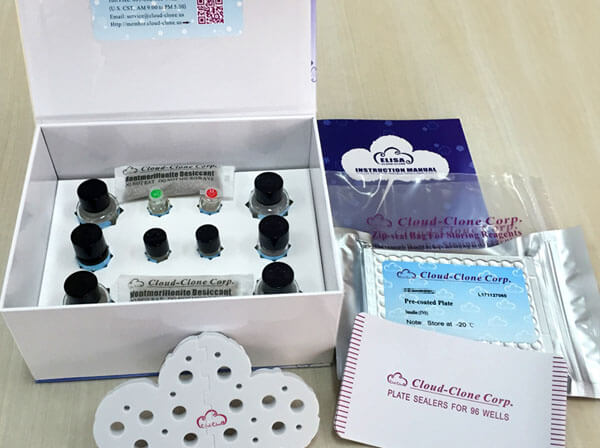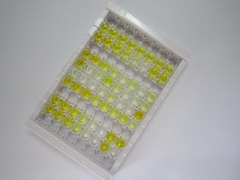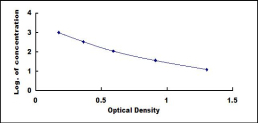ELISA Kit for Calcitonin (CT) 

CALCA; CALC1; KC; CCP; PDN-21; Katacalcin; Calcitonin carboxyl-terminal peptide
- UOM
- FOB US$ 504.00 US$ 720.00 US$ 3,240.00 US$ 6,120.00 US$ 50,400.00
- Quantity
Overview
Properties
- Product No.CEA472Ca
- Organism SpeciesCanis familiaris; Canine (Dog) Same name, Different species.
- ApplicationsEnzyme-linked immunosorbent assay for Antigen Detection.
Research use only - DownloadInstruction Manual
- CategoryMetabolic pathwayEndocrinologyHormone metabolismBone metabolism
Sign into your account
Share a new citation as an author
Upload your experimental result
Review

Contact us
Please fill in the blank.
Recovery
Matrices listed below were spiked with certain level of recombinant Calcitonin (CT) and the recovery rates were calculated by comparing the measured value to the expected amount of Calcitonin (CT) in samples.
| Matrix | Recovery range (%) | Average(%) |
| serum(n=5) | 79-95 | 90 |
| EDTA plasma(n=5) | 97-105 | 102 |
| heparin plasma(n=5) | 93-101 | 97 |
Precision
Intra-assay Precision (Precision within an assay): 3 samples with low, middle and high level Calcitonin (CT) were tested 20 times on one plate, respectively.
Inter-assay Precision (Precision between assays): 3 samples with low, middle and high level Calcitonin (CT) were tested on 3 different plates, 8 replicates in each plate.
CV(%) = SD/meanX100
Intra-Assay: CV<10%
Inter-Assay: CV<12%
Linearity
The linearity of the kit was assayed by testing samples spiked with appropriate concentration of Calcitonin (CT) and their serial dilutions. The results were demonstrated by the percentage of calculated concentration to the expected.
| Sample | 1:2 | 1:4 | 1:8 | 1:16 |
| serum(n=5) | 84-98% | 81-104% | 93-105% | 91-99% |
| EDTA plasma(n=5) | 80-93% | 81-94% | 93-101% | 81-89% |
| heparin plasma(n=5) | 85-99% | 79-96% | 79-89% | 78-95% |
Stability
The stability of kit is determined by the loss rate of activity. The loss rate of this kit is less than 5% within the expiration date under appropriate storage condition.
To minimize extra influence on the performance, operation procedures and lab conditions, especially room temperature, air humidity, incubator temperature should be strictly controlled. It is also strongly suggested that the whole assay is performed by the same operator from the beginning to the end.
Reagents and materials provided
| Reagents | Quantity | Reagents | Quantity |
| Pre-coated, ready to use 96-well strip plate | 1 | Plate sealer for 96 wells | 4 |
| Standard | 2 | Standard Diluent | 1×20mL |
| Detection Reagent A | 1 | Assay Diluent A | 1×12mL |
| Detection Reagent B | 1×120µL | Assay Diluent B | 1×12mL |
| Reagent Diluent | 1×300µL | Stop Solution | 1×6mL |
| TMB Substrate | 1×9mL | Instruction manual | 1 |
| Wash Buffer (30 × concentrate) | 1×20mL |
Assay procedure summary
1. Prepare all reagents, samples and standards;
2. Add 50µL standard or sample to each well.
And then add 50µL prepared Detection Reagent A immediately.
Shake and mix. Incubate 1 hour at 37°C;
3. Aspirate and wash 3 times;
4. Add 100µL prepared Detection Reagent B. Incubate 30 minutes at 37°C;
5. Aspirate and wash 5 times;
6. Add 90µL Substrate Solution. Incubate 10-20 minutes at 37°C;
7. Add 50µL Stop Solution. Read at 450 nm immediately.

Test principle
This assay employs the competitive inhibition enzyme immunoassay technique. A monoclonal antibody specific to Calcitonin (CT) has been pre-coated onto a microplate. A competitive inhibition reaction is launched between biotin labeled Calcitonin (CT) and unlabeled Calcitonin (CT) (Standards or samples) with the pre-coated antibody specific to Calcitonin (CT). After incubation the unbound conjugate is washed off. Next, avidin conjugated to Horseradish Peroxidase (HRP) is added to each microplate well and incubated. The amount of bound HRP conjugate is reverse proportional to the concentration of Calcitonin (CT) in the sample. After addition of the substrate solution, the intensity of color developed is reverse proportional to the concentration of Calcitonin (CT) in the sample.
Giveaways
Increment services
Citations
- Effect of consumption of fatty acids, calcium, Vitamin D and boron with regular physical activity on bone mechanical properties and corresponding metabolic hormones in ratsNiscair: 13737
- The effect of supplementation of calcium, vitamin D, boron, and increased fluoride intake on bone mechanical properties and metabolic hormones in ratPubMed: 22782709
- Interleukin-2 and Lanreotide in the Treatment of Medullary Thyroid Cancer: In Vitro and In Vivo StudiesPubmed: 23884781
- Effect of whole body vibration on healthy rat plasma parametersEbscohost: Source
- Effect of consumption of fatty acids, nutrients and regular physical activity on bone mechanical properties in ratsPubmed:22439438
- Differences in biochemical and genetic biomarkers in patients with heart failure of various etiologies.pubmed:27448535
- Cell-matrix signals specify bone endothelial cells during developmental osteogenesis.pubmed:28218908
- Effects of fatty acids, nutrients and whole body vibration on bone histomorphometry, mechanical properties and metabolic parameters in male rat10.22192/ijarbs.2017.04.04.018
- p75NTR−/− mice exhibit an alveolar bone loss phenotype and inhibited PI3K/Akt/β‐catenin pathwayPubmed: 32215984
- Paracrine signalling by cardiac calcitonin controls atrial fibrogenesis and arrhythmiaPubmed: 33149301
- Copeptin in fluid disorders and stressPubmed:35143773

















